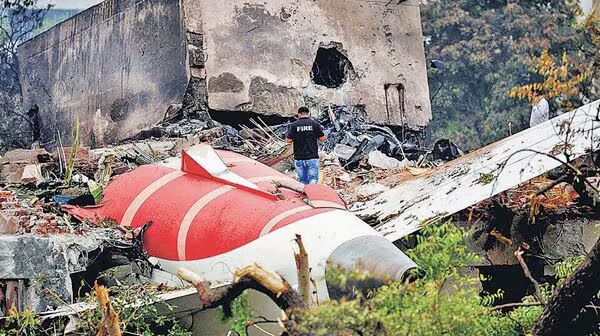On a seemingly routine flight day, tragedy struck when Air India Flight 171, a Boeing 787 Dreamliner, crashed shortly after takeoff, resulting in the loss of over 240 lives. As the aviation world reels from the incident, the release of the preliminary investigation report has uncovered an unexpected and disturbing cause: both engines were manually shut down mid-air just seconds after liftoff.

The revelation has sparked shock across the global aviation community, raising pressing questions about cockpit procedures, pilot actions, and possible systemic failures. This article explores the key findings of the report, expert opinions, and what may come next in one of India’s most devastating air disasters in recent memory.
✈️ What Happened to Air India Flight 171?
The preliminary report on the tragic crash of Air India Flight 171 has revealed shocking and unusual findings. The aircraft, a Boeing 787-8 Dreamliner, experienced complete engine failure seconds after takeoff. Investigators have confirmed that both engines were manually shut down using cockpit switches, causing the plane to lose power and crash shortly after liftoff.
The crash claimed the lives of 241 people, including passengers, crew members, and 19 individuals on the ground. Only one person survived the catastrophic event.
⏱️ Timeline of the Crash
08:07:37 UTC – Aircraft begins takeoff roll.
08:08:39 UTC – Aircraft becomes airborne.
08:08:42 UTC – Engine 1 fuel control switch moved to “CUTOFF”.
08:08:43 UTC – Engine 2 fuel control switch moved to “CUTOFF”.
Few seconds later – Both engines shut down mid-air.
Crash – Aircraft descends rapidly and crashes beyond the airport perimeter.

🛠️ Mechanical Failure or Human Action?
The most alarming detail in the report is that both engine fuel control switches were moved to the OFF position within one second of each other—a move that is not possible accidentally according to aviation experts.
These switches are mechanical and protected against unintentional activation. Moving them requires a pull-push mechanism that is deliberate and takes effort. The simultaneous shutdown of both engines raises questions about whether it was a pilot error or an intentional act.
🎧 Cockpit Voice Recorder Reveals Tense Moments
The Cockpit Voice Recorder (CVR) captured a chilling exchange between the two pilots:
Pilot 1: “Why did he shut it off?”
Pilot 2: “I didn’t.”
This exchange suggests confusion and panic in the cockpit as the crew tried to comprehend the engine shutdown. Both pilots attempted to restart the engines, but the aircraft did not have enough altitude or airspeed to recover.
The automatic deployment of the Ram Air Turbine (RAT) confirms that the engines lost power entirely and electrical systems were switching to emergency backup.
🧠 Human Error or Intentional Act?
There are currently two main theories:
1. Pilot Error
One theory suggests that the pilot(s) mistakenly activated the fuel cutoff switches, possibly during a checklist procedure or due to confusion in the cockpit. However, experts argue that such a dual mistake, within one second, is extremely rare.
2. Intentional Sabotage
The other theory being considered is intentional action by a crew member, either due to mental distress or deliberate sabotage. Investigators are now examining the backgrounds, mental health, and recent behavior of both pilots to rule out or confirm this theory.
🔧 FAA Advisory Was Ignored by Airline
A past 2018 FAA advisory warned airlines about possible fuel cutoff switch lock disengagement due to wear and tear. However, the advisory was not mandatory, and Air India did not implement the recommended changes. Investigators are also looking into whether this contributed to the incident.
📋 What the Investigation Will Focus On
The Indian Aircraft Accident Investigation Bureau (AAIB) is now digging deeper into multiple angles:
Review of the flight data and cockpit voice recordings.
Examination of the switch mechanisms and flight controls.
Background check of both pilots, including psychological evaluations.
Maintenance logs and response to past advisories.
Analysis of crew communication, training, and behavior.
The final report may take several more months and will likely include recommendations to improve cockpit procedures, fuel system design, and crew assessments.
📢 Public and Expert Reactions
Aviation professionals and the public have expressed shock and disbelief. Online forums like Reddit and Lemmy are buzzing with debates:
“It’s almost impossible to accidentally shut off both engines. This looks intentional.” – Reddit user
“These switches are heavily protected. One person must have done this on purpose.” – Aviation mechanic
While these are only speculative reactions, they reflect the intense scrutiny and concern surrounding this tragic event.
🧯 Could This Have Been Prevented?
Had the aircraft maintained engine power, it would have climbed normally and avoided the crash. The manual cutoff of both engines was the direct cause of the crash. Whether due to human error or intentional action, this was not a mechanical malfunction, according to early findings.
This raises serious questions about pilot screening, mental health checks, and cockpit control safeguards in modern aircraft.
📝 Final Words: A Tragedy That Must Lead to Change
The crash of Air India Flight 171 is one of the most shocking aviation tragedies in recent Indian history. The early report shows that engine shutdown was not due to malfunction, but a manual action inside the cockpit.
As the investigation continues, the world watches closely. If confirmed as a deliberate act or preventable error, this tragedy may lead to sweeping changes in aviation safety standards, pilot monitoring, and cockpit system design.
Tags: Air India tragedy, pilot error crash, aviation investigation India, engine failure Boeing 787, Air India 2025 news, Flight 171 update.


